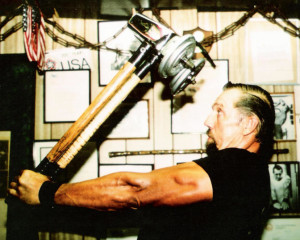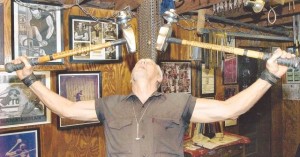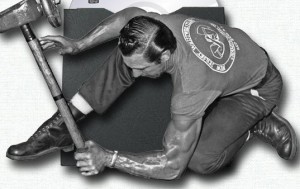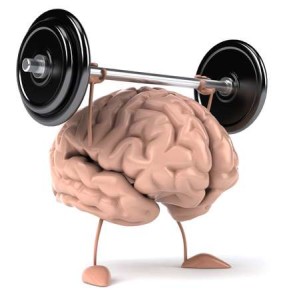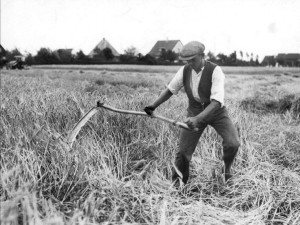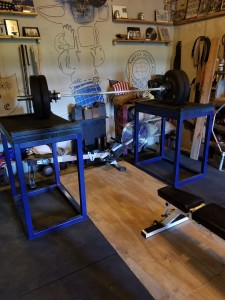Article Submitted by Thom Van Vleck
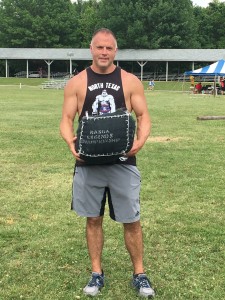
Tedd holding the sheaf with which he broke the master’s world record. The sheaf is tossed over a crossbar for height with a pitchfork.
Off the Clock: Highland Games Champion Tedd Van Vleck
An incredible fitness journey and a world record! The Jackson Weightlifting Club strikes again!
Many of us make resolutions to lose weight and get in shape, but life sometimes gets in the way. Meeting those goals is difficult, but not impossible, as BNSF Business Analyst Tedd Van Vleck has learned. Over the past several years, Tedd has surpassed his fitness goals, losing 85 lbs. and becoming a world record-holder in one of the most challenging sporting events in the world: The Scottish Highland Games.
Ted’s fitness journey began with inspiration from his older brother, Thom, who always stayed in good shape.
“When I turned 40, my brother told me, ‘You can be in the best shape of your life when you’re 45 if you get started now.’ He advised that it’s much easier to stay healthy when you get older if you begin early and stick with it,” said Tedd.
Around the same time, Tedd got sick with the flu. On a visit to a nearby clinic, he weighed himself and discovered that he’d need to be more than 7 foot tall for his weight to be considered healthy. Tedd is 6’1”. The clinic visit was a wake-up call. And, with his brother’s encouragement, Tedd began to change his lifestyle.
Even small things, like giving up the Mountain Dew he used to drink at work, cut hundreds of calories from his diet each week. He began making healthier switches, like opting for a cauliflower crust pizza from the store over just ordering delivery pizza. Over time Tedd got into the habit of eating lower calorie foods that he could still enjoy.
“It’s easy to lose track of the calories you consume, even when you think you’re eating healthy snacks,” he said.
He started using a fitness app to track the foods he was eating and found that many foods marketed as being “healthy” were actually misleading. Doing his own research and consulting a nutritionist allowed Tedd to discover what foods worked best to keep his calories and nutrients on target.
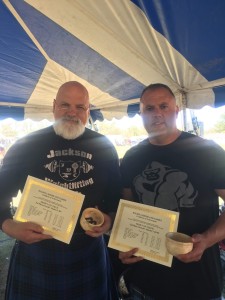
Thom and Tedd Van Vleck both winning in their class at the Wichita Highland Games
Changing his mindset allowed Tedd to lose weight and keep it off.
“I used to celebrate special events by going out to eat, but it’s dangerous to use food as a reward,” Tedd explained. “Now I celebrate by doing something like bowling or rock climbing with friends instead.”
Tedd says that along with your diet, focusing on your long-term results and performance is important to getting fit. That’s where the Highland Games come in. The Highland Games are Olympic-like sporting events similar to modern track and field that take place all over the world. True to the Scottish heritage of the competition, all participants wear kilts.
Tedd got into the Highland Games in 1994, once again with the support of his older brother Thom. A few years before Thom had traced the Van Vleck family lineage to Scotland and became interested in the Highland Games. Initially Tedd made fun of his brother for his involvement in the kilt-wearing sporting event, but then he tried it himself. To date, Tedd estimates he’s been to around 500 Highland Game competitions.
“It started out as a fun thing to do with my brother,” Tedd said. “I didn’t start seriously training until a few years ago.”
In June of this year Tedd participated in the U.S. Nationals in Glasgow, Ky. While there, Tedd broke the World Record in the Masters 40-49 Lightweight Division for the Sheaf Toss. The previous record of 30’0” was set in 2009. Not only did Tedd break the record initially with a throw of 30’1”, he bested his own new record with a throw of 32’1”. He placed 3rd overall at these games and qualified for the World Championships to be held this November in Tucson, Ariz.
Earlier this year Tedd had his first international win in Santiago, Chile, where he set the field record in the sheaf toss for all weight classes. For an American to hold a world record in a Scottish sport is a big deal and was a goal of Tedd’s since he began his fitness journey in 2015. Now that he’s achieved that, he’s focusing on becoming a well-rounded thrower, and hopefully making it to the podium during the World Championship this year.

Tedd Van Vleck in Germany for the Master’s World Championships of Highland Games in 2018
Tedd keeps up with his competition workouts and his healthy eating habits throughout the year. Even when he’s traveling for work, he manages to keep up his workout schedule and opt for healthier meals when eating at restaurants. When he doesn’t have access to good gym facilities, he makes the best with what he has, like running up and down flights of stairs at the hotel or doing lunges across hallways.
“People think they need to join a gym to get in shape,” Tedd explained, “But there’s so much you can do with nothing at all, or even just a chair!”
When asked what advice he has for people trying to get in shape, Tedd says there are five key things:
- Sleep: You want eight hours of sleep, or seven at the minimum. When we’re sleep deprived our mental strength is weakened and we act differently. Tedd says it’s more important to him to get enough sleep than to get a workout in.
- Water: Being hydrated is extremely important for our health and should be a priority. Tedd drinks a gallon of water each day and starts his day with a drink of water as soon as he wakes up.
- Nutrition: Making sure we get the nutrients we need is important to helping our bodies function at full capacity. Tedd says to think of what we’re eating as fuel in a car. We need to put in good-quality fuel for it to drive and function properly. That being said, everyone has different nutrition and dietary needs based on our body type and genetic factors.
- Stretching: Stretching can help stimulate circulation, increase flexibility and reduce lactic acid buildup, the cause of sore muscles, after working out. Tedd does light stretching every morning, and often stretches while watching TV in the evenings instead of just sitting on the couch.
- Working out: Cardio and weight training are both important to losing weight and becoming more fit. Gaining muscle makes it easier to burn more calories when working out, Tedd says.
Even though Tedd has achieved a lot since he turned 40, he acknowledges that there are always ups and downs when it comes to his fitness and weight loss. Tedd credits the support of others in helping him reach his goals.
“My brother Thom is my biggest fan,” Tedd said. “He’s very supportive of me.”
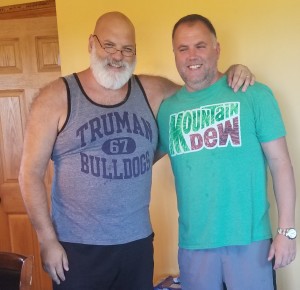
Thom and Tedd. Best friends who happen to be brothers.
BNSF Regional Wellness Manager Adrienne Davis has also been a huge encouragement to him. He said Adrienne helped him initially establish a work/life balance, and that she continues to keep in touch.
Next up for Tedd is training for the Highland Games World Championship that will take place this November. His supporters and fellow employees at BNSF are sure that with his focus and determination, Tedd will continue to achieve great things.
